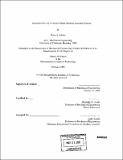Segmented binary control of shape memory actuator systems
Author(s)
Selden, Brian A., 1980-
DownloadFull printable version (4.558Mb)
Other Contributors
Massachusetts Institute of Technology. Dept. of Mechanical Engineering.
Advisor
Haruhiko H. Asada.
Terms of use
Metadata
Show full item recordAbstract
A new approach to the design and control of shape memory alloy (SMA) actuators is presented. SMA wires are divided into many segments and their thermal states are controlled individually as a group of finite state machines. Instead of driving a current to the entire SMA wire and controlling the wire length based on the analogue strain-temperature characteristics, the new method controls the binary state (hot or cold) of individual segments and thereby the total displacement is proportional to the length of the heated segments, i.e. austenite phase. Although the thermo-mechanical properties of SMA are highly nonlinear and uncertain with a prominent hysteresis, Segmented Binary Control is robust and stable, providing characteristics similar to a stepping motor. However, the heating and cooling of each segment to its bi-stable states entail longer time and larger energy for transition. An efficient method for improving speed of response and power consumption is developed by exploiting the inherent hysteresis of SMA. Instead of keeping the extreme temperatures continuously, the temperatures return to intermediate "hold" temperatures closer to room temperature but sufficient to keep constant phase. Coordination of the multitude of segments having independent thermal states allows for faster response with little latency time even for thick SMA wires. Based on stress dependent thermo-mechanical characteristics, the hold temperature satisfying a given Stress Margin is obtained. The new control method is implemented using the Peltier effect thermoelectric devices for selective segment-by-segment heating and cooling. Experiments demonstrate effectiveness of the proposed method.
Description
Thesis (S.M.)--Massachusetts Institute of Technology, Dept. of Mechanical Engineering, 2005. Includes bibliographical references (p. 51).
Date issued
2005Department
Massachusetts Institute of Technology. Department of Mechanical EngineeringPublisher
Massachusetts Institute of Technology
Keywords
Mechanical Engineering.